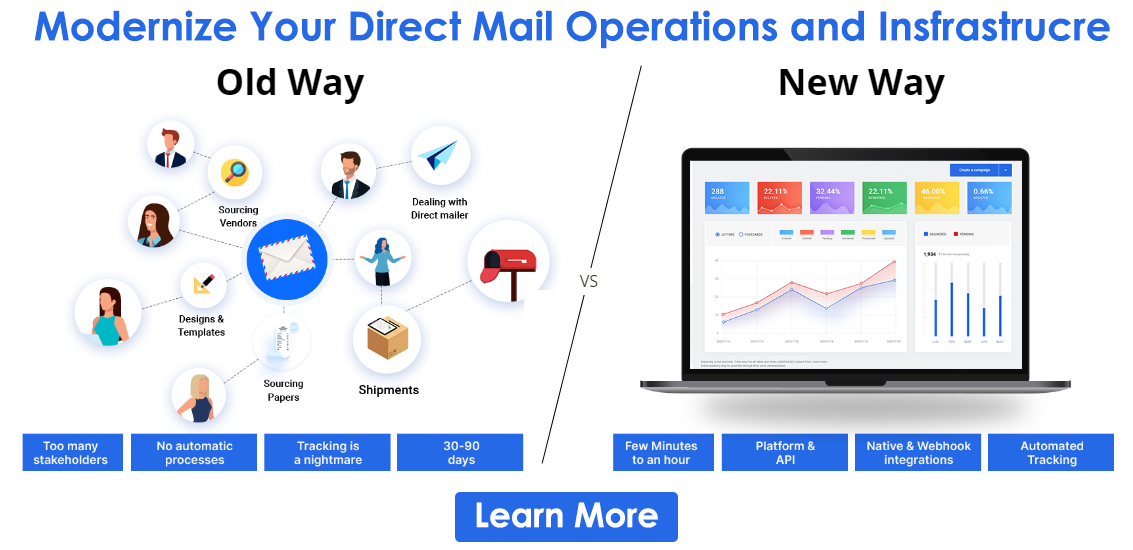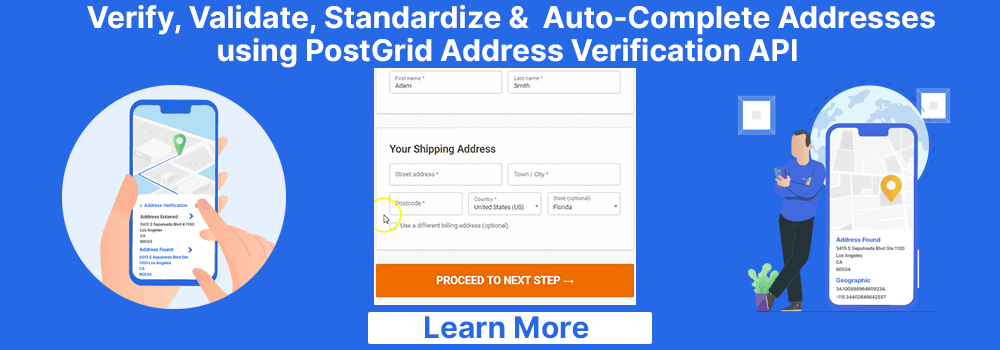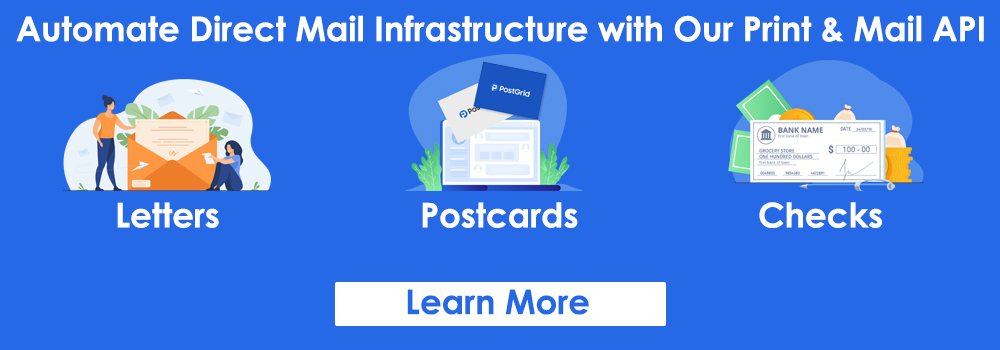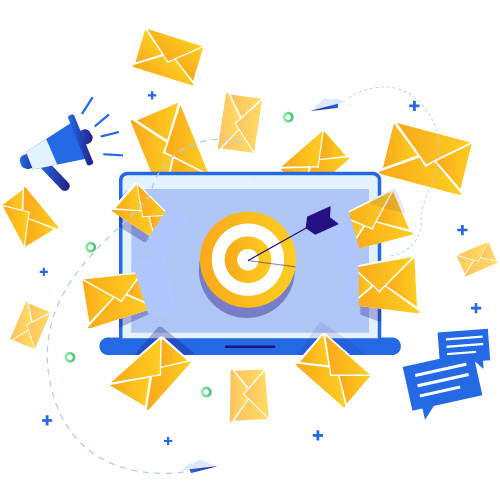
Direct Mail Marketing: What Is It and How Can It Be Made More Effective?
If you think, “Direct mail marketing is dead, why do I bother myself reading about ways to make it more effective?” then you’re dead wrong.
Direct mail marketing solutions are thriving, and most businesses, despite their size, are implementing it as a powerful marketing strategy, depending on their product, volume, and target audience. And we have statistics to prove that.
73% of American consumers would rather like the brands to contact them through direct mail because it gives them the freedom and ease to read whenever they want. The reason for this is that direct mail is tangible.
Despite going majorly digital, marketers and the audience still find paper-based marketing more reliable, especially for the greatest generation and the baby boomers.
Plus, compared to 20-30% of emails, a whopping 90% of direct mail gets opened.
Surprising, isn’t it?

Furthermore, direct mail requires 21% less of your cognitive effort than drafting and sending an email.
And don’t you want to lessen the burden on your staff to channel their potential better?
If you want to talk about ROI, then know that direct mail offers a 29% return on investment, which is equivalent to the output of your social marketing efforts.
Having established the prominence of direct mail marketing in 2020, let’s discuss some direct mail advertising basics. Especially why, despite several digital marketing channels that have proved their prowess, does direct mail marketing still hold an unwavering position in this competitive scenario?
What is Direct Mail Marketing?
In direct mail marketing, your business sends out tangible mail to prospects, clients, and customers—a digital equivalent of email marketing.
Direct mail marketing is done through direct mail services like the United States Postal Service or Canada Post, depending on the nation you’re conducting the marketing.
It involves conducting audience research, building a mailing list, creating campaigns based on the industry’s trends and developments, and then sending it through mail to the respective recipient(s).
An effective way of conducting offline communication, direct mail marketing, aims to connect, inform, and engage with prospects and customers using postcards, flyers, letters, brochures, catalogues, invoices, and more.
What Makes Direct Mail Marketing a Strong Tool Even in 2025?
1. Psychological Effect
Let’s begin with one of the most common reasons for the growing prominence of direct mail in this digital marketing era — the psychological effect.
If you’re anything like me, a consumer, which by the way, we all are and have been relying heavily on digital platforms for multiple purposes, you would have by now learned the art of avoiding, deleting, or spamming the sales digital marketing emails.
We are all human beings, and the psychological fact dictates, always we have always relished receiving physical gifts, but we still do.
Direct mail marketing does exactly that by sending your potential customers letters, postcards, and flyers in their mailboxes. It makes them feel valued and appreciated by the brand’s efforts in creating and sending personalized mail. It further reflects on qualified lead generation, brand awareness, visibility, and enhanced customer engagement.
2. An Interactive Medium
Its tangible personality, which gives customers the freedom to see and read it as and when they want to, garners relatively more attention. A personalized and well-executed direct mail campaign can help your business expand and strengthen your audience base.
As human beings, we make our decisions based on how our senses perceive things. Direct mail marketing activates most of our thoughts with its interactive format, which eventually reflects the improved engagement rate.
3. Memorable
When designed, created, and mailed to the target audience strategically, direct mail makes a unique marketing tool. And if click with the audience and they find it interesting, you can leave it on word-of-mouth marketing to increase your business’s visibility and boost your brand awareness.
4. Better Reach
Your direct mail marketing campaign will have a better reach if your target audience comprises the generation that’s not so active on social media or still prefers reading newspapers in their tangible form.
The greatest generation is a good case in point, as it’s most likely to purchase through checking out items in the direct mail over browsing on the internet. Yet, we can’t say that direct mail marketing won’t appeal to millennials or Gen Z.
Launching a generation-specific direct mail marketing campaign requires businesses to identify, address, and resolve the pain points with tailor-made direct mail. Along with a broader reach, a well-designed and implemented direct mail strategy can maximize the possibility of getting a response and enhance engagement.
5. Less Competition
A significant percentage of companies across the industries are apprehensive about and do not invest in any physical marketing tool, such as direct mail, with their digital marketing techniques. It has made it easier for businesses to launch direct mail marketing campaigns to get in front of the target audience.
Furthermore, your consumers do not anticipate mail in their mailbox, so when a tailor-made, creative, and well-designed brochure or catalogue arrives in their mailbox, they open and read it. If the mail can touch their pain point by offering services that can resolve it, then those leads are more likely to convert into paying customers. Leverage this lack of competition by launching creative, personalized, and highly targeted direct mail campaigns.
6. Connects With All Age Groups
Whether you’re a teenager, a professor, or retired personnel. For instance, not every generation is social media savvy like the greatest ones.
Your personalized and creative direct mail that identifies and provides solutions to specific problems can reach your target audience – despite the demographics.
As mentioned before, everyone gets excited about opening and reading direct mail from their mailbox – regardless of their age group. You can benefit from this situation due to the lack of competition.
7. High Return on Investment
As mentioned before, the ROI of direct mail marketing is equivalent to that of social media marketing. But what you don’t know is that when we look closer to the response rate, direct mail marketing stands strong at 5.3% for mail sent to homes and 2.9% for those tailored to the prospects.
Wondering what the response rate of social media is? It’s 0.6%.
Yes, direct mail has a better response rate and guarantees a higher ROI when launched strategically.
8. Enhanced Targeting
Most people think that only digital marketing campaigns can target a specific and large audience base, but they’re wrong. Direct mail marketing acts as a fantastic process to send the right message to a particular customer at the right time.
With Canada Post, you can deliver customized mail to different customers in different postal codes. All you need to know to make your direct mail marketing highly specific is your business goal and the target audience. You can rest assured that the campaign will deliver desirable results.
9. Boost Online Communication
Apart from being a valuable offline marketing tool, direct mail marketing can complement your digital marketing strategy making them more effective and ensuring a better Return on investment.
For instance, sending direct mail with a scannable QR code can increase your product’s customer engagement multifold. Combining digital marketing techniques with direct mail will boost your brand’s awareness and visibility.
10. Trackable
You might be wondering how an offline mode of communication can be trackable, right? And it is a legitimate question to ask.
Technically, you can’t track your direct mail campaign’s performance, but if you strategize well, your campaign might become trackable. How?
Dedicate a unique telephone call line to the specific direct mail campaign. It helps you identify from which campaign your leads are calling you. Thus, you can find out which of your direct mail campaigns is performing better than the other ones.
 Also Read: How to Track Direct Mail Campaign?
Also Read: How to Track Direct Mail Campaign?11. Fear of Missing Out
Since direct mail is an uncommon thing now, when consumers get a few mail in their mailbox, they feel an urge to check out what’s in it and fear losing out on something. The curiosity and concern of missing out make them open the mail and read it. And if it’s highly targeted and the target audience finds it relevant, they buy your product. The fear of missing out or FOMO results in direct mail getting complete attention.
12. Boosts Brand Awareness
Being one of the most tangible marketing tools, with the possibility of staying in the customer’s vicinity relatively top other offline communication tools, increases your brand awareness to a significant level. But it’s important to note that it’s consistency that boosts your brand awareness.
Even if your target audience overlooks the consistent mail pieces, your brand’s logo, name, and service will remain in their heads. So if they’re ever looking for a product similar to the ones that you sell, your brand’s name and logo will be the first to pop up in their minds.
Well, the fact is that direct mail marketing remains a viable and appealing option despite the availability of a large number of digital marketing platforms.
Thanks to the competition, online marketing has numerous disadvantages, including low response rates, limited visibility, and limited creative options. But, what if we say these, however, are the benefits of direct mail marketing?
Marketing Direct Mails: Why Does it Work?
When talking of direct mail marketing, our professionals at PostGrid believe that it works better than other advertising or marketing methods. It is simply because, unlike clutter from online marketing, direct mail marketing taps into the positive psychology of the customers.
To avail the advantages of direct mail you should keep the following in mind:
Customers Open, Scan & Read Physical Mailers
Imagine taking your mail inside from the mailbox after walking out there. What will you do with the mail that you receive? Do you throw it in the bin, or do you open it & read to see what is in there?
Well, if you open & read, you are not alone! The United States Postal Service estimates that 53% of citizens residing in America read their physical mail every month. While 21% like scanning it at least once a week.
So, it proves that direct mail is more likely to be seen by many recipients.
Now, here’s one of the biggest benefits of direct mail- What do you think? It Is Very Tangible
Many customers wish to receive brand messages through direct mail items. According to reports, around 59% of customers/residents agreed that they like receiving direct mail from businesses to know about newly launched products.
In contrast to online marketing messages, substantial marketing messages have more appeal. For instance, you can put a physical mailer in a wallet, on the refrigerator, or on the notice board of your workstation as a reminder. Areas like these are personal and can’t be accessed through other methods.
 Also Read: Direct Mail for Small Business
Also Read: Direct Mail for Small BusinessBenefits of Direct Mail Marketing
Direct Mail Marketing Campaigns are Highly Targeted
With all the information related to the consumers available today, direct mail offers the best opportunity to maximize marketing results. Besides names, contacts, and addresses, it is possible to buy consumer data that includes details about occupations, purchase choices, age groups, etc.
One of the major benefits of direct mail marketing is that you can easily define or target your ideal persona more authentically with better personalization and relevance for each batch of mailings.
Provides you with Unlimited Creativity & Versatility
Yes, you read that right!
When compared to digital alternatives, direct mail provides you with unlimited creative possibilities. Social media ads and online banners allow text and photo changes. There’s no tactile component, and the size is standardized. A user can only see one-liner or short text in an email before clicking, making it even worse.
The physical nature of direct mail offers enhanced creativity. Any design can be personalized by adding textures, changing sizes, sending 3D objects or even adding scratch-and-sniff options. This increases the likelihood of catching the attention of recipients, enticing them with content, and engaging them in your marketing message.
Simplicity at the Best
Direct mail may seem complex with all the talk of targeting, personalization, and creativity, but it isn’t. The correct list, a simple design, and a reliable mailing partner can all help you launch a campaign with a positive ROI.
At PostGrid, our experts think that the right print & mail automation software also helps you reap the best benefits of direct mail advertising. As a result, this is an excellent marketing method for businesses from startups to large or well-established ones, including Fortune 500 companies and nearby vendors.
Easy to Monitor The Progress
Despite direct mail’s difficulty in monitoring, a variety of techniques are available to marketers for measuring the effectiveness of campaigns.
- Through Website: Direct mail campaigns are commonly conducted by using a custom webpage or even a landing page and posting the URL or web address on your mail items. Alternatively, you can create & add a PURL that redirects to a pre-populated page. The process is simplified and quicker this way. They can also be used to track the actions taken by recipients.
- Through Phone Numbers: If you want to document and forward calls to your current number, you can create unique or campaign-specific phone numbers for your direct mail marketing campaign. By doing so, you can determine which of your marketing techniques produces the best outcomes.
- Through Various Offers: Direct mail can be used to provide various discounts & offers. Once you have collected an appropriate number of submissions, you can simply track them.
Direct Mail helps you Ramp Up the Back-End Fulfilment
Adding more to the advantages of direct mail! Direct mail allows you to identify when demand is likely to increase. And you can prepare yourself accordingly when launching a campaign. Apart from this, online ads tend to be more volatile.
A campaign can become effective or go viral at any time. The ad clicks, mail responses and demand may explode, overtaking fulfilment, which requires extensive tweaking and testing. Since direct marketing does not guarantee success, it does not eliminate the uncertainty. As a result, you can ramp up production when necessary to combat it.
Now that you know the working & benefits of direct mail. Let us now move ahead and talk about the other aspects of the same.
 Also Read: Healthcare Mailing List
Also Read: Healthcare Mailing ListDirect Mail Marketing Cost Estimations
Depending on how you plan and budget your campaign, direct mail marketing costs can vary considerably. The overall cost involves much more than selecting a gift. Some other components to consider in your marketing campaign include:
- A collateral item, such as a notecard may require printing costs.
- Costs associated with designing printed collateral and personalizing it.
- Packages are charged a different shipping fee.
- Shipment, tracking, follow-up, and reporting are performed using human capital.
Please note: You may come across different benefits of direct mail advertising by using a platform like PostGrid.
Opting for Automated Direct Mail Marketing
To start with this section, let us look back in time!
During an event, the CEO of PostGrid beautifully highlighted the benefits of direct mail marketing.
According to him- Since the beginning of printed direct mail letters, marketing professionals have been looking for ways to automate complicated processes to leverage the best of marketing power. Implementing direct mail campaigns manually involves your management doing a lot of legwork, but direct mail marketing automation is powerful.
The manual process requires:
- Continuous and ongoing campaign planning, creation, and implementation
- Sourcing and/or developing mail items, packing materials, gift cards, welcome kits and printed collateral
- Undergoing overwhelming management of warehousing
- Manually tracking the delivery or customer response and following up the next day
- And exemplifying or calculating ROI after the send
Automating direct mail with a platform like PostGrid is the most effective way to ensure these campaigns are effective without requiring manual labour and team time. Click here to learn more about PostGrid.
Quick Tips to Personalize Your Direct Mail Advertisement
Automated direct mail offers many powerful advantages related to personalization. A one-to-one connection with customers helps you create a much stronger bond than a simple gift could ever achieve. The return on investment from personalization is credible even though it takes time to successfully implement. The brands that offer personalization to customers tend to attract many. And their customers spend more with them when they do.
Personalized items can include a handwritten note to show you’ve done your research or beautiful packaging that resonates personally with your customers. Although this type of personalization requires a bit of work, the rewards are far greater than the effort expended.
 Also Read: Healthcare Marketing Agency
Also Read: Healthcare Marketing AgencyDO's and DONT's of Direct Mail Marketing
Having read all the benefits of direct mail marketing, you must be wondering what some of the most effective ways to launch a direct mail marketing campaign are. Let’s find that out in the form of do’s and don’ts, so you not only know what to do to launch an effective direct mail marketing campaign for earning maximum benefit but also what you should avoid to keep them from falling flat.
DOs
A Thorough Preparation
Preparation is the key. It’s what lays the foundation of a successful direct mail marketing campaign. Start with the common tried and tested method of 40-40-20. According to this approach — 20% of your direct mail marketing campaigns’ success depends on content, design, images, and delivery date, 40% on your offer, and how it stands out from the contemporaries and the rest of 40% on the quality of your mailing list.
Understand and Define The Objective
A direct mail with cluttered text and disconnected information is going to end up in the trash. That’s why it’s crucial for you as a marketer to completely comprehend what you want to achieve through this specific direct mail campaign.
Focus On Knowing and Defining the Audience
It’s essential to identify and define your target audience for every campaign that you’re going to launch. Not every discount or offer is relevant to each group of your targeted audience. That’s why it’s important to define your target audience and build a specific mailing list for each of your campaigns.
Run Test On The Market
Come up with a different combination of how you’ll launch your campaign and test them in the market. Take a small area and create different combinations of designs, discounts, and the audience to test the effectiveness and the ROI of your campaign. It’ll help you figure out which strategy would deliver higher returns.
Create An Impressive Call To Action
Needless to say, an eye-catching call to action is going to boost your campaign’s effectiveness. Your direct mail should have a clear and fascinating call to action to convey how your products or services stand out most concisely.
A Detailed Proofreading
We cannot focus enough on how necessary thorough proofreading is. A minor typo or formatting problem may ruin your brand’s image in your customer’s mind. After all, this shows your seriousness about your business and reflects on the quality of your products and services. Check and fix all grammatical or punctuation errors. Get it proofread by other editing experts to get a second opinion and correct any mistakes that you might have overlooked.
A Quality Analysis
When we talk about quality, we mean how the direct mail is printed and whether the design elements used are pleasing to the eye or not. It’s essential to perform proper quality analysis and control to ensure that every mail you send is crisp. Unless you have expert designers on your team, we would suggest automating the printing process with direct mail printing software as the best option.
With an automated solution, you get the freedom to choose from a wide range of templates and customize them as per your business and target audience’s requirements. And as far as printing quality is concerned, quality automation software ensures a 100% premium class.
 Also Read: Direct And Indirect Marketing Examples
Also Read: Direct And Indirect Marketing Examples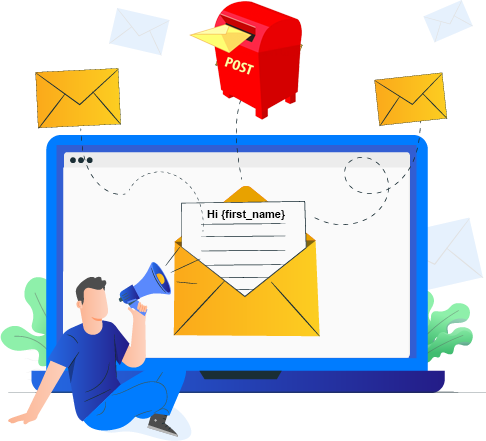
Don’ts
Forget to Follow-up
Follow-ups in offline communication are as important as in online communication since targeting is a tricky task. Send a thank-you note or a mail to your regular customers for their contribution.
Miss Out On Adding Value
We understand that direct mail is uncommon, but that doesn’t give you the liberty to make it generic. Be specific with what you’re offering and add value to the consumer’s purchase cycle. Send out direct mails with offers that have limited time validity. It’ll compel your audience to take immediate action.
Clutter The Mail
It’s one of the most common mistakes made in direct mail – cluttering. To make sure that your target audience knows everything about the discount or the product you’re offering, don’t go overboard with the texts, images, or CTAs. Maintain a nice balance of all, and keep the mail — whether it’s a flyer, postcard, brochure, or a letter — nice, clean, and to the point.
Send Mail To Everyone
If you think that mass mailing to everyone will guarantee you better results, you’re highly mistaken. As mentioned earlier, define and understand your objective, which helps you narrow down your target audience. Mass mailing to uninterested consumers will only waste your time, effort, and money.
Wondering what tips can help you make direct mail marketing effective?
Direct mail marketing will boost ROI when:
- It’s unique
- The audience feels valued
- It has a premium-quality printing
- It lacks a sales tone
- It has an eye-catchy CTA
- Proper usage of colour and white space is made
- It includes crucial information
- The right medium is used- postcard, letter, brochure, flyer, or other
Conclusion
We hope that through this blog, you will be able to gain the knowledge and processes required to create, track, and send effective campaigns to expand your outreach. The digital marketplace is cluttered and noisy, and you need to increase the return on your marketing spend.
Free your staff from the burden of repetitive and mundane tasks by incorporating Postgrid’s direct mail automation solution. Our advanced API to send direct mails will help you save time and money, yielding a higher return on investment automatically and cost-effectively.
Streamline and simplify your direct mail workflow with PostGrid’s automated solution.


